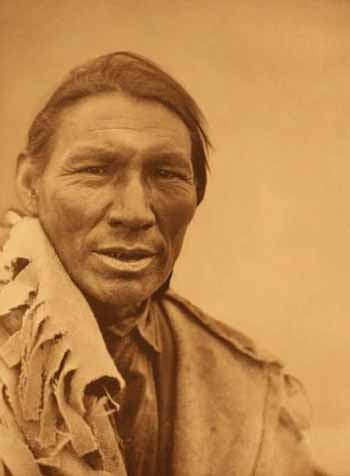
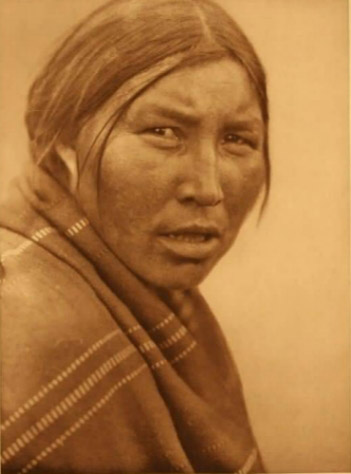
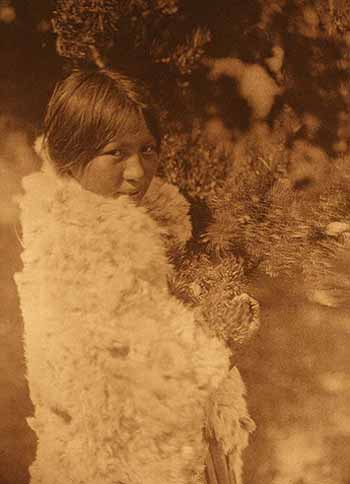
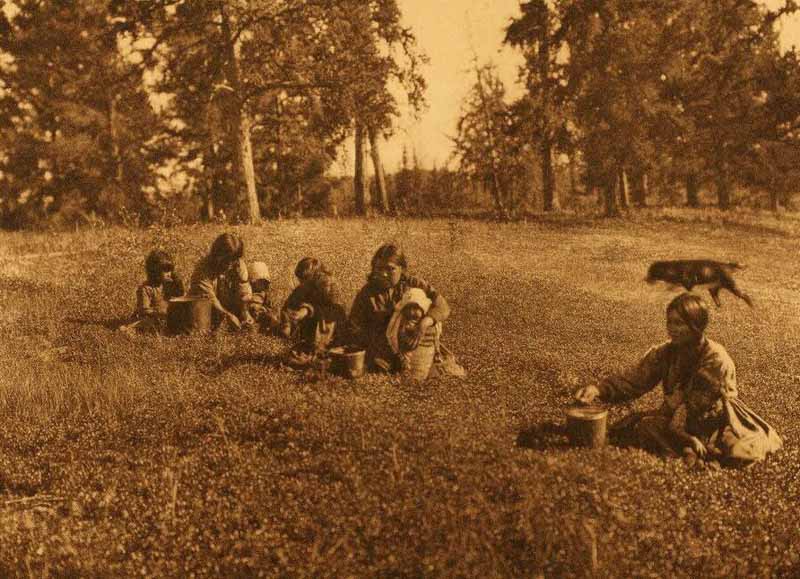
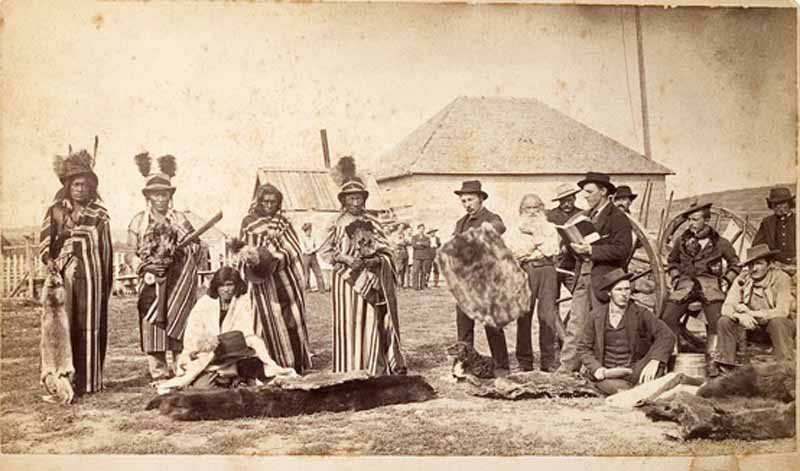





The Cree are one of the largest groups of First Nations / Native Americans in North America, with 200,000 members living in Canada. The major proportion of Cree in Canada live north and west of Lake Superior, in Ontario, Manitoba, Saskatchewan, Alberta and the Northwest Territories. About 15,000 live in eastern Quebec. In the United States, this Algonquian-speaking people historically lived from Lake Superior westward. Today, they live mostly in Montana, where they share a reservation with the Ojibwe (Chippewa). The documented westward migration over time has been strongly associated with their roles as traders and hunters in the North American Fur Trade.
They are the largest group of First Nations in Canada with over 200,000 members. The Cree were known for openness to inter-tribal marriage. The Metis are a group of mixed Cree and primarily French Canadian heritage, although it is generally accepted in academic circles that the term Metis can be used to refer to a combination of any Aboriginal and European lineage.
The Cree are the largest group of First Nations in Canada, with over 200,000 members and 135 registered bands.This large population may be a result of the Crees' traditional openness to inter-tribal marriage. Together, their reserve lands are the largest of any First Nations group in the country. The largest Cree band and the second largest First Nations Band in Canada after the Six Nations Iroquois is the Lac La Ronge Band in northern Saskatchewan.
The Metis (from French - any person of mixed ancestry) are people of mixed ancestry, such as Nehiyaw (or Anishinaabe) and French, English, or Scottish heritage. According to Aboriginal Affairs and Northern Development Canada, the Metis were historically the children of French fur traders and Nehiyaw women or, from unions of English or Scottish traders and northern Dene women (Anglo-Metis). Generally in academic circles, the term Metis can be used to refer to any combination of persons of mixed Native American and European heritage, although historical definitions for Metis remain. Canada's Indian and Northern Affairs broadly define Metis as those persons of mixed First Nation and European ancestry.
The Quebec Cree nation calls its homeland Eeyou Istchee - Cree for Land of the People.
They are a Cree nation in Northern Alberta, Canada. They have been embroiled with the Government of Canada regarding land claims for decades. Their primary complaint is that oil and gas development on or near their land has dangerously threatened their way of life, their culture, and the health of those in their community.Amnesty International has commented on the struggle of the Lubicon by issuing a report imploring the Canadian government to respect the land rights of the Lubicon.
Largely left alone by the Government of Canada during initial colonization and settlement of the New World, by the late 19th century a move was made by the government to isolate and relocate members of the Nisichawayasihk Cree Nation to a single, pre-defined location which no European Settlers had expressed an interest in. This area was defined by the government in the agreement known as Treaty 5, a document which established that NCN Band Members and their descendants were guaranteed certain rights and benefits.
During the 1960s and 1970s, massive hydroelectric developments were underway in northern Manitoba. Consequently, large areas of traditional hunting, fishing, and trapping lands were severely flooded. The people of Nisichawayasihk were forcibly relocated to their current location.
NCN is a signatory to the Northern Flood Agreement between Manitoba Hydro, the Province of Manitoba, and several First Nations Communities. Since 1999, NCN has been engaged in talks with Manitoba Hydro regarding a 33% share in the construction and ownership of another hydroelectric project called Wuskwatim. Successful completion of this agreement would see NCN as an equal partner in this project, sharing in both construction and startup costs, as well as earning revenue from this development.
With a population of approximately 2,000, Nisichawayasihk Cree Nation is a large and widespread community. Many of its residents are still living in third-world conditions. The local infrastructure does not support full water and sewage services to all residents, and many still rely on fresh water and liquid waste to be hauled in and out by truck from holding tanks.
In early February, 2004, the nearby City of Thompson, Manitoba announced their approval to Nisichawayasihk Cree Nation to convert a parcel of NCN-owned property within Thompson to Treaty Land. This was possible due to shortages in land area controlled by NCN under the Treaty Land Entitlement agreement in the mid-1970s. This event marks one of the few transitions from privately owned land, purchased by a First Nations community, to being declared an Urban Reserve.
This plan has been quietly discussed between city and band administration since the narrowly-lost plebescite held in Thompson on September 18th, 2001. With a 45% voter turnout for the plebescite, and amid allegations of inappropriate voter disqualifications, the "no" side won by a margin of 250 votes. During the three years following the plebescite, the majority of Thompson City Counselors have publicly stated that the results of the vote were not binding upon city council, as the council has been elected to act in the best interests of the citizens of Thompson.
At one time the Cree were located in northern Minnesota, North Dakota and Montana. Today they live as part of the federally recognized Chippewa Cree tribe, located on the Rocky Boy Indian Reservation in Montana. They share the reservation with the Pembina Band of Chippewa Indians, who form the "Chippewa" half of the Chippewa Cree tribe. (In Canada the Chippewa are known as Ojibwa.) Traditionally, the southern limits of the Cree territory in the United States were the Missouri River and the Milk River in Montana.
Originally inhabiting a smaller nucleus of this area, the Cree Nation expanded rapidly in the 17th and 18th centuries after acquiring firearms and beginning their fur trade with the Europeans, but wars with the Dakota and Blackfeet and severe smallpox epidemics, notably in 1784 and 1838, reduced their numbers.
The Cree assumed the living patterns of those with whom they came into contact, so that there were two major divisions: the Woodland Cree, also called Swampy Cree, or Maskegon, whose culture was essentially an Eastern Woodlands type, though their environment denied them maize cultivation and made them rely wholly on hunting; and the Plains Cree, who, living on the northern Great Plains, became bison hunters.
The
Woodland Cree preferred hunting caribou, moose, bear, and beaver but relied chiefly on hare because of the scarcity of the other animals; the periodic scarcity of hare too, however, caused famine, leading to occasional cannibalism (reported in tribal tales as well as by Europeans). Various kinds of fowl were also sought. Social organization was based on bands of related families, though large groups allied for warfare. Fear of witchcraft and respect for all variety of taboos and customs relating to the spirits of game animals pervaded Cree culture; shamans and conjurers wielded great power.The
Plains Cree, after acquiring horses and firearms, were more militant than the Woodlands Cree, raiding and warring against many other Plains tribes. Though reportedly divided into 12 bands, each with its own chief, the Plains Cree had but one integrated military society. Religion and ceremony were highly valued, seemingly as means of fostering success in war and the bison hunt. The Assiniboin were the traditional allies of both the Plains and Woodland Cree.
Their ancestral Cree language was once the most widely spoken in northern North America, but now not all Crees are fluent in it. English and French are more commonly used.
The Cree language (also known in the most broad classification as Cree-Montagnais, Cree-Montagnais-Naskapi, to show the groups included within it) is the name for a group of closely related Algonquian languages spoken by approximately 117,000 people across Canada, from the Northwest Territories to Labrador. It is the most widely spoken aboriginal language in Canada. The only region where Cree has official status is in the Northwest Territories, together with eight other aboriginal languages.
The two major groups: Nehiyaw and Innu, speak a mutually intelligible, Cree dialect continuum, which can be divided by many criteria. In a dialect continuum, "It is not so much a language, as a chain of dialects, where speakers from one community can very easily understand their neighbors, but a Plains Cree speaker from Alberta would find a Quebec Cree speaker difficult to speak to without practice."